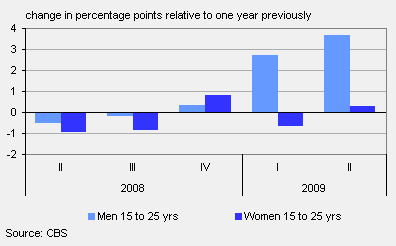Considerable increase youth unemployment

Unemployment in the young population is rising rapidly; from 9.3 percent in the second quarter of 2008 to 11.4 percent in the same period this year. Young people are often the first to suffer the consequences of a recession.
Young people often the first to suffer the consequences of a recession
If conditions on the labour market deteriorate in a period of economic crunch, young people are usually the first to be affected. This was particularly true of the 1980s. In 1983, unemployment among 15 to 25-year-olds soared to 17.3 percent.
With 8.2 percent, unemployment among over-25s was significantly lower then. In general, youth unemployment rapidly declines when the economy picks up.
Unemployment by age

Sharp increase unemployment among young men
Over the past months, young men were seriously affected by the recession. In the second quarter of 2009, the unemployment rate for men aged between 15 and 25 was 11.8 percent, i.e. 3.7 percentage points up on one year previously.
The rate among young women, on the other hand, remained more or less stable. With 11.0 percent, female unemployment was even lower than male unemployment.
Men more often employed in cyclically sensitive areas
Unemployment among young men has risen sharply because they tend to work in cyclically sensitive sectors of the labour market, e.g. manufacturing industry, ICT, transport and construction. Many women are working in health care and social services, a sector which, as yet, appears to be recession-proof.
Youth unemployment by gender

Young people without basic qualification hit hardest by the recession
Young people aged between 15 and 25 without a basic qualification, who were not attending any form of education were affected most dramatically by the recession. In the second quarter of 2009, the unemployment rate in this age category rose to 15.2 percent, nearly 6 percentage points higher than twelve months ago.
With 6.7 percent, the unemployment rate among young people leaving school with a proper qualification was 3 percentage points higher in comparison to last year.
Those who were still in school were hardly affected by the downturn on the labour market. Unemployment in this category grew by 0.7 percentage points.
Youth unemployment among people not attending any form of education by basic qualification

Lian Kösters and Paul den Boer